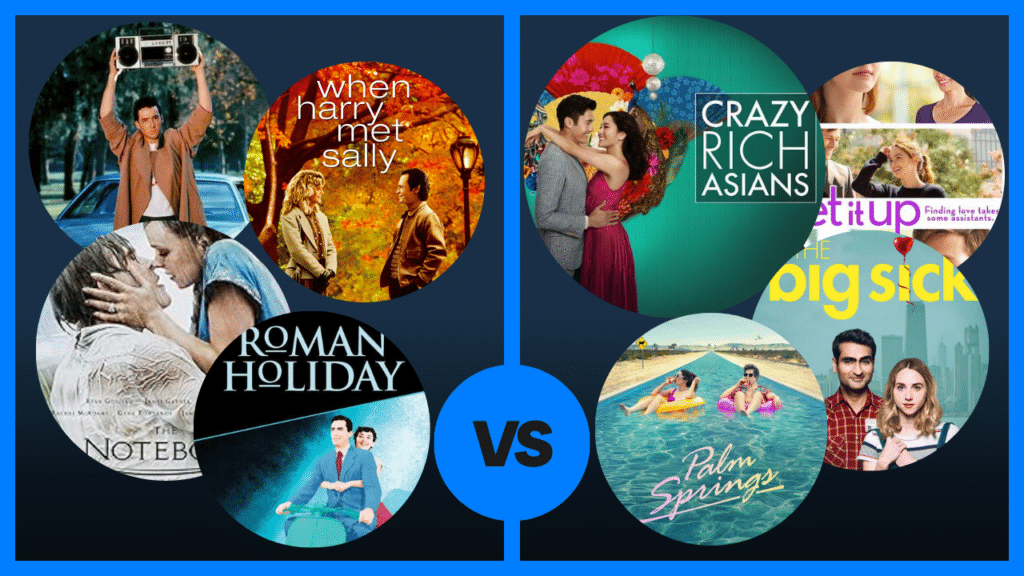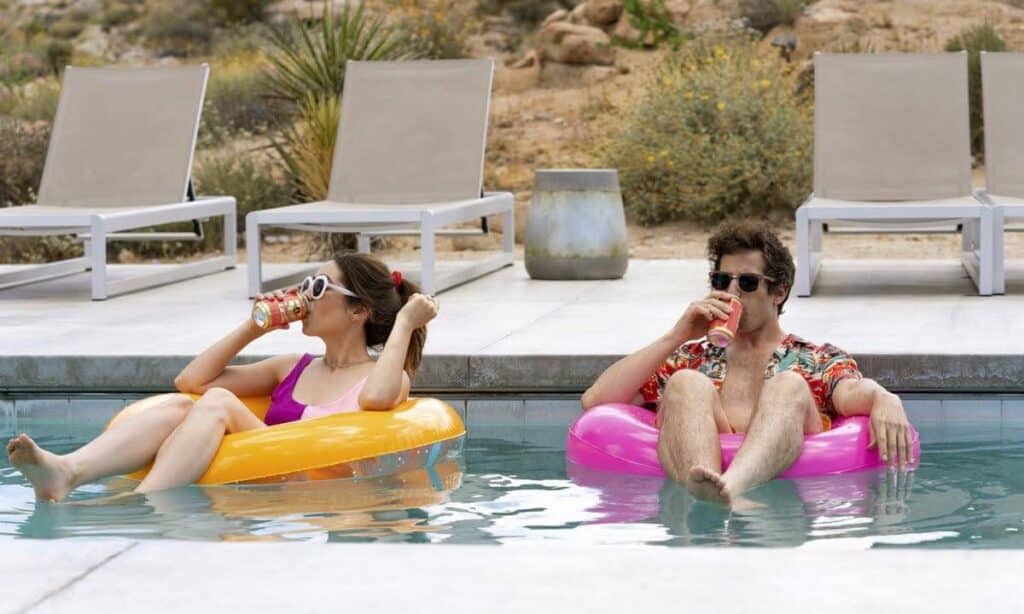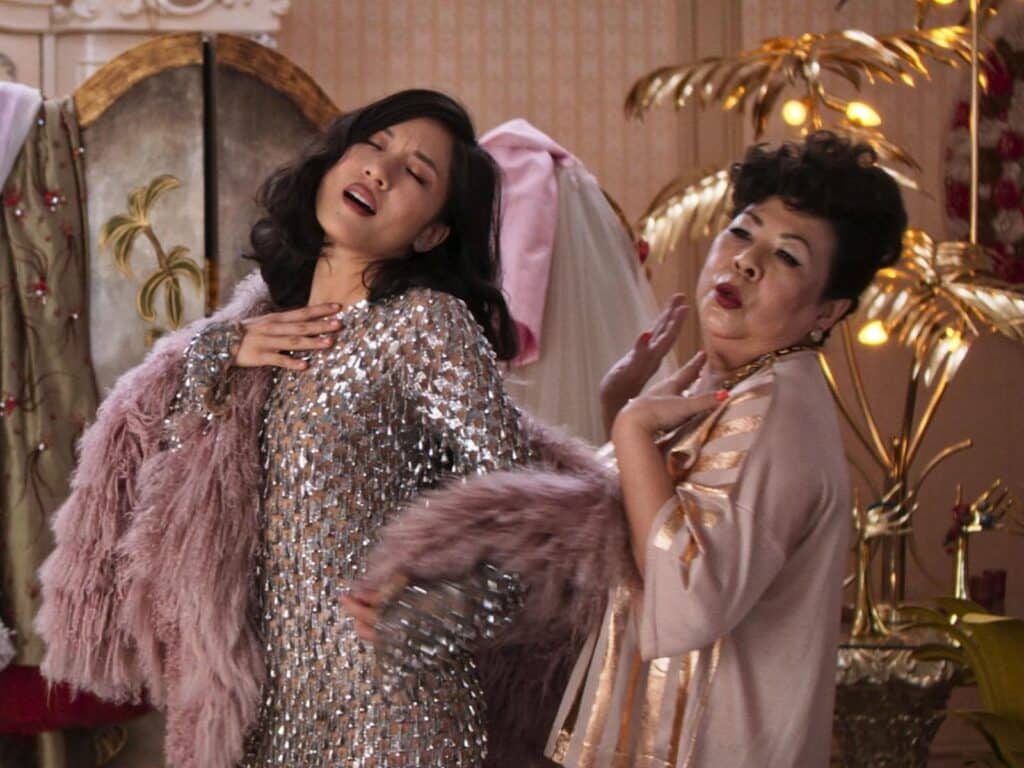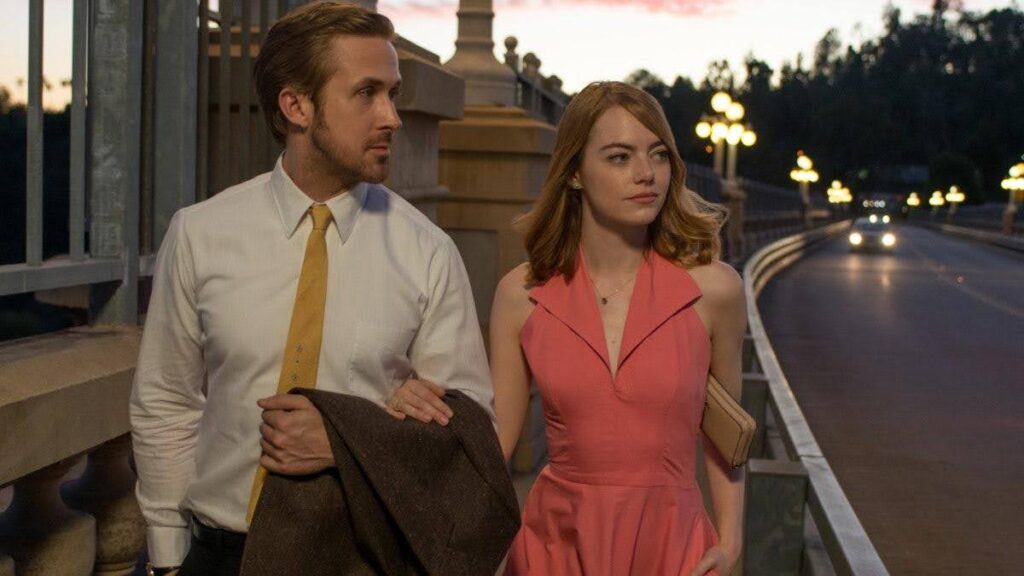
You didn’t think we were done with romantic comedies, did you? Kicking off from our first blog on how to write a rom-com, today we’re putting old against new by going head to head: classic vs. contemporary romantic comedy.
Romantic comedies have long held a special place in storytelling, delivering a delightful mix of humor, romance, and emotional depth. With a rom-com you know you’re going to be wrapped in a cozy, feel good blanket of romance.
Like many other genres, rom-coms have evolved over the history of cinema, reflecting culture changes, moving audience expectations and storytelling trends. But one thing that hasn’t changed about rom coms is their exploration of the complexities of love in charming and witty ways.
In today’s article, we’ll dive into what makes a classic romantic comedy, and how their contemporary counterparts have shaken things up since. Plus, we’ll be offering our tip tips for crafting your own timeless yet fresh rom-com!
The Classic Rom-Com: Timeless Elements and Structure
The structure of a classic romantic comedy is timeless for a reason – it just works! While there is always some sort of variation, most classic rom-coms follow a formula covering three main elements: the meet-cute, obstacles, and resolution.
These structural pillars provide a roadmap that can take audiences on a compelling journey, often leading to the kind of ending that leaves our hearts fluttering!
Let’s break down each of the key elements of classic rom-com with two of the most recognizable classic rom-coms in cinematic history – When Harry Met Sally (1989) and Notting Hill (1999)
The Meet-Cute (The First Encounter)
A hallmark of classic rom-coms, the meet-cute is the moment when the two romantic leads meet for the first time. This is often a serendipitous moment which can be awkward, downright hilarious, and sometimes both.
This first meeting isn’t just about introducing the audience to the characters, but about planting the seeds of chemistry and hinting at the couples unfolding dynamic. When Harry and Sally first meet in When Harry Met Sally, it’s anything but a romantic encounter. They’re thrown together on a road trip and spend most of it arguing whether men and women can be friends. This friction sparks the tension that underpins their relationship throughout the film. Let’s remind ourselves of the moment they met:
Similarly, Notting Hill gives us a quintessential meet-cute when bookshop owner William accidentally spills orange juice on Hollywood superstar Anna. This chance meeting sets the stage for their vastly different worlds to collide, blending William’s very ordinary life with Anna’s extraordinary one.
Check out the famous scene here:
Obstacles
Once the meet-cute has set up the foundation of the relationship, obstacles are then introduced to test the developing bond between the two characters.
Such challenges can be anything from misunderstandings, differences in social class, interfering friends or family, or even the characters’ own flaws and insecurities. It’s usually a mix of internal and external conflict that put the characters through their paces.
For instance, Notting Hill explores the tension between William’s humble lifestyle and Anna’s glamorous, high-profile career. This stark contrast between their worlds creates tension and doubt, even as they’re drawn to each other even more.
This moment where William goes to see Anna is a real turning point when he realizes maybe they aren’t as compatible as he first thought, their very different lifestyles clear:
The obstacle in Harry and Sally’s way in When Harry Met Sally is more psychological than external. Both are unwilling to admit their romantic feelings for one another, preferring to preserve their friendship. This denial adds layers of complexity to their relationship, keeping the audience invested.

Resolution
The final act of the classic rom-com is when love triumphs, but not before the characters face a dramatic turning point. This usually involves one character making a grand gesture or a heartfelt confession to win back the other.
Like Harry’s mad dash through New York City on New Year’s Eve to tell Sally he loves her, or when Anna asks William if he could “possibly just love her”. Both pivotal moments are culminations of everything the audience has been hoping for as well as profoundly emotional moments that feel earned after the difficulties of both their journeys. Satisfying pay offs all around. Let’s relive them:
You’ll notice that classic rom-coms often wrap up with closure and an air of optimism, leaving us basking in the glow of a well told love story. But just how are contemporary rom-coms changing the mold?
Whether you’re sticking to tradition or breaking the mold, Celtx has the tools you need.
The Contemporary Rom-Com: Shaking Up the Formula
Yes, classic rom-coms will always resonate with us, but contemporary filmmakers have also found ways to reinvent the genre, blending the traditional elements we know and love with fresh approaches.
Modern rom-coms reflect shifts in cultural norms, audience expectations and storytelling styles to offer us new perspectives on love and relationships. Let’s take a look at some of the more recent rom-coms that are bucking the trend!
Genre Blends and Subversions
One of the most notable changes in contemporary rom-coms is their willingness to blur genre lines. Many incorporate elements of science fiction, drama or even horror which expand the scope of what a rom com can be. This is, of course, also while delivering the emotional core of the love story.
In 2020’s Palm Springs, filmmakers combined the rom-com formula with a time-loop premise, injecting sci-fi into the narrative. Nyles and Sarah’s repeated days in a single moment of time provides a unique backdrop for their very relatable love story.
The backdrop challenges to confront their feelings for each other and their existential struggles.

If we also look at The Big Sick, we notice a romantic comedy balanced with an autobiographical drama. Kumail Nanjani and Emily V Gordon’s screenplay explores cultural differences, illness, and family dynamics to create a deeply personal story that hits us with humor and romance in equal measure.
Shifts in Audience Expectations
With countless options of movies of any genre with the rise of streaming services and films generally just becoming more accessible, audiences crave authenticity and diversity in stories more than ever.
In response to this, contemporary rom-coms often feature characters and relationships that reflect a broader range of experiences and breaking free from the mainly white, heteronormative lens of classic rom coms. A landmark movie that reflected this is Crazy Rich Asians, with an all-Asian cast. With a balance of humor, drama and cultural commentary, the movie also kept everything we love about a classic rom-com. It just proves that representation and commercial success can go hand in hand!

To All the Boys I’ve Loved Before has also subverted genre conventions. This movie particularly resonated with younger audiences for its relatable teenage protagonist, Lara Jean and her swoon-worthy yet grounded love story. The film freshly approached adolescent romance with our favorite rom com traditions.
Embracing Imperfect Endings
As we mentioned earlier on, classic rom-coms often conclude with a neat resolution. What we ‘re finding more and more is that contemporary rom-coms are willing to embrace ambiguity or bittersweet endings.
The acknowledgment that not all love stories fit neatly into a box is now widely accepted, tapping into audiences in a way that rom coms have never done before. Take La La Land, where the protagonists part ways to pursue their dreams, leaving us with a mix of joy and heartbreak. The film celebrates that love can be meaningful even if it doesn’t last forever, challenging the expectation of ‘happily ever after’.

The Half of It also focuses on personal growth and self-discovery rather than romantic resolution. We spend the movie with Ellie Chu, a shy teen who helps her classmate Paul write love letters to Aster, the girl Ellie secretly loves. The movie doesn’t end with Ellie and Aster together but Ellie’ journey helps her to gain the courage to embrace her identity and leave her small town for new opportunities.
Applying the Evolution: Tips for Modernizing Rom-Com Structure
Whether you’re creating a classic rom-com or experimenting with contemporary trends, the key to a successful script is balancing familiarity with innovation. This section provides tips on how to apply the lessons learned from the evolution of the genre.
For a complete, step-by-step guide to writing your entire script, be sure to check out our full resource: How to Write a Rom-Com Script
Nail the Meet-Cute (But make it your own)
The meet-cute is the foundation of the rom-com genre, so you don’t want to skimp on this moment. Instead, focus on creating a first encounter that feels unique to your characters and sets the tone for their relationship.
Perhaps consider unexpected settings or circumstances to really draw your audience in. Maybe your characters meet at a protest, in a virtual reality game, or while taking part in an obscure hobby. No matter what you choose, ensure the interaction reveals something essential about each of your characters’ flaws and desires.
Create Obstacles that Matter
The best rom-com obstacles are those that aren’t just random inconveniences but are deeply tied to the characters’ personal growth. Consider what each of your characters fears or desires most and let those internal conflicts shape the external challenges they face.
For example, if one of your characters is afraid of displaying vulnerability, maybe their love interest challenges them to open up. This kind of approach helps your obstacles to feel authentic and meaningful, meaning your audience is more likely to buy into your characters and their bond.
Play with Structure and Genre
Experimentation is part of the fun! Don’t be afraid to try something new with the structure of your rom-com or incorporate elements from other genres. A non-linear timeline, an unreliable narrator, or a fantastical twist can add a little extra spice to your story while keeping the romance front and center.
Don’t get too carried away, though, and remember to stay grounded in your characters’ emotional journeys. No matter how inventive your structure, your audience still needs to connect with the romance.
Need help structuring your story? Try our blogs on the Three-Act and Five-Act Structures
Reflect Real-Life Diversity
Audiences are hungry for movies that reflect the world around them. When writing your rom com, consider exploring relationships that go beyond traditional tropes, such as LGBTQ+ love stories, interracial couples, or characters with disabilities.
By highlighting a wider range of experiences, which demonstrate the reality of the world around us, you can create a story that feels both inclusive and authentic.
Who needs Closure?
While classic rom-coms often deliver a tidy resolution with bows and ribbons on, contemporary audiences are open to endings that feel more nuanced. Instead of a neat conclusion, focus on crafting an ending that resonates emotionally, even if it doesn’t tie up every single loose end.
It doesn’t matter if your characters end up together or go their separate ways. The audience only cares that the ending feels meaningful and true to who your characters are.
FAQs About Romantic Comedy Structure and Evolution
The main structural difference lies in the Resolution. Classic rom-coms demand a definitive, unambiguous “happily ever after” conclusion. Contemporary rom-coms often embrace nuance and ambiguity, where the characters may end up happy but not necessarily together, focusing instead on personal growth and self-discovery.
Cute is the memorable, often awkward or humorous, first encounter between the two romantic leads. While it remains a crucial trope, contemporary rom-coms frequently subvert it (e.g., meeting virtually, meeting under extreme duress) or delay it to build tension, but the moment itself is still necessary to establish the initial chemistry and conflict.
A compelling rom-com obstacle must be tied to the characters’ internal flaws or fears. It shouldn’t be a random external event. For instance, a character who fears commitment is forced to choose between a comfortable denial (the internal flaw) and a public grand gesture (the external obstacle).
A romantic comedy script generally follows the standard three-act structure and adheres to the 90-110 page range (90–110 minutes of screen time). Comedies often run slightly shorter than dramas to maintain a fast pace.
Conclusion
Romantic comedies continue to captivate audiences by exploring love in all its messy, humorous, and heartfelt brilliance. Whether you lean toward the timeless charm of classic romcoms or the bold innovation of contemporary trends, the genre is still a stalwart for storytelling.
By blending familiar tropes with fresh perspectives, reflecting real-world diversity, and embracing the beauty of imperfect endings, writers can craft romcoms that feel both timeless and uniquely their own. Romcoms will always have a place in our hearts, as we celebrate the universal search for connection.
Focus on your story, not your formatting.
Let Celtx’s Script Editor automatically apply all industry rules while you focus on the story.
Up Next:

Internal Conflict: The Invisible Battle That Drives Your Story
Now that you’ve mastered the external structure of the rom-com, it’s time to perfect the internal journey. Most great love stories are fundamentally about the characters overcoming a personal flaw (fear of vulnerability, pride) before they can find love. Learn how to write this psychological struggle with our deep dive
